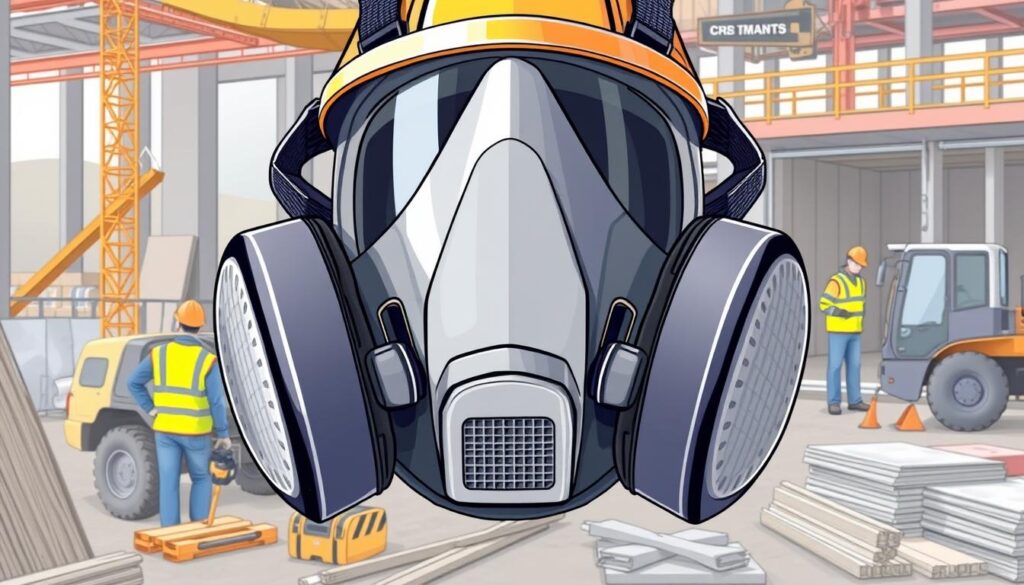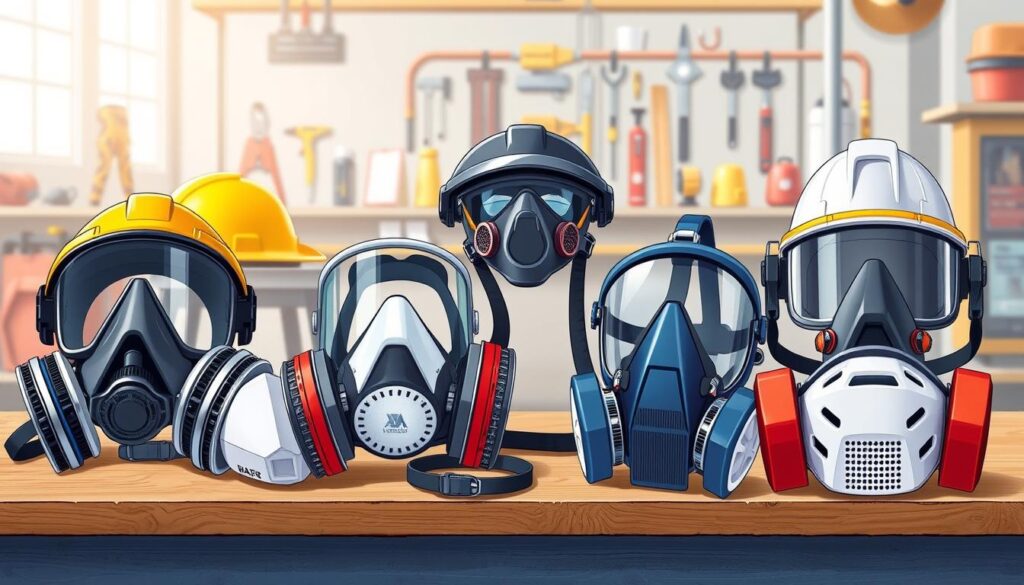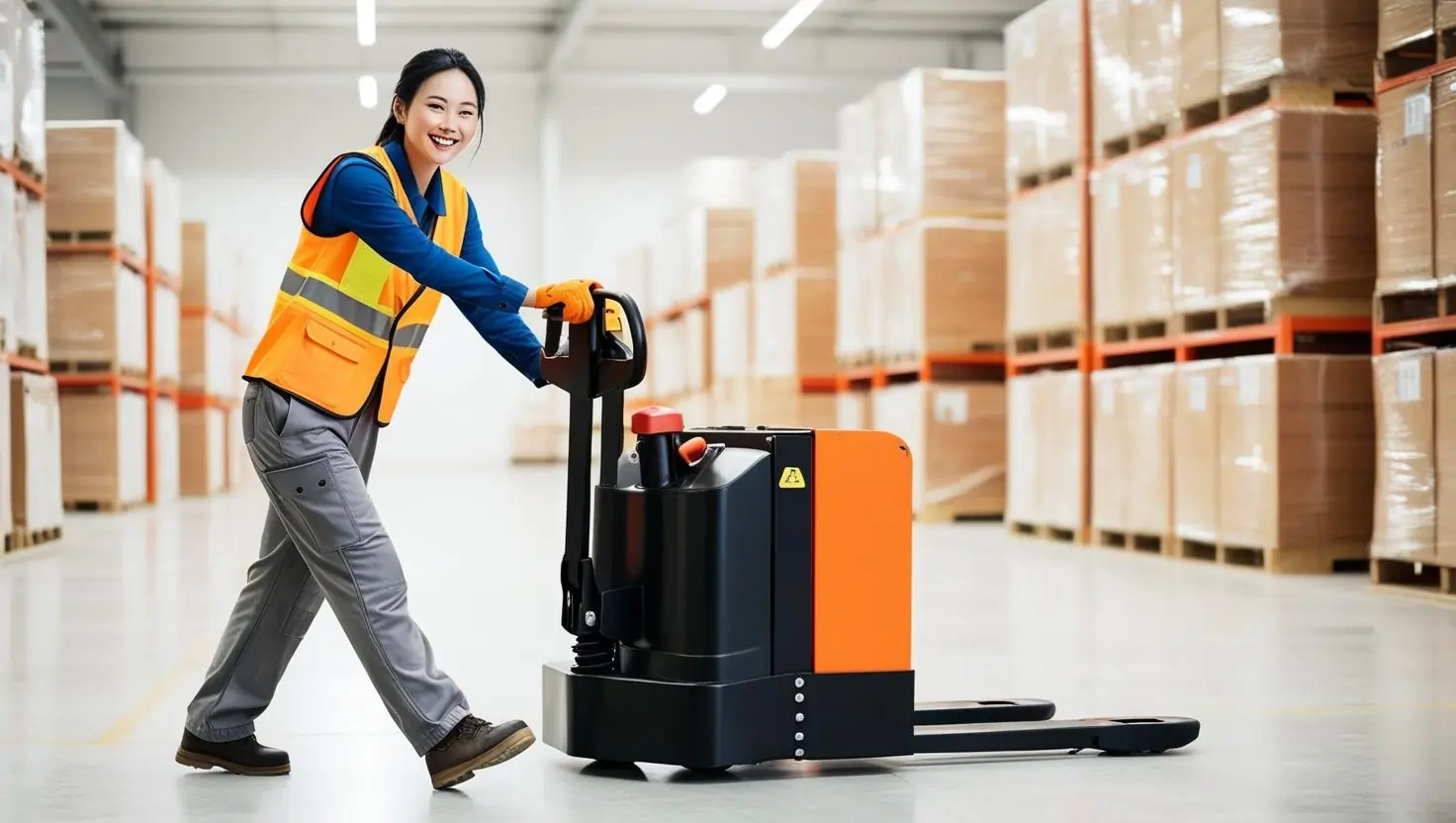As a construction worker, your role in safeguarding your breathing health is paramount. Different Job sites have potential dangers and airborne particles. Selecting the proper respirator is not just significant; it’s crucial, as it directly impacts your safety and well-being. This article will empower you with the knowledge to make an informed decision that keeps you safe and ensures compliance with regulations.
Imagine you’re embarking on a new construction job filled with anticipation and readiness. However, before diving in, you must select the appropriate respirator. Where do you begin? The answer lies in your ability to learn about the importance of respiratory protection and the various respirators designed for construction. With your capacity to absorb new information, you can confidently make the right choice, feeling empowered and in control of your safety.

Key Takeaways
- Respirators are vital for keeping your breathing safe in construction.
- There are many different models, each for different dangers and places.
- It’s essential to get a good fit and training for your respirator.
- Keep and replace your respirator as the maker says to stay safe.
- Think about your workplace and the dangers of picking a respirator.
Free Resource: Half Facepiece Respirator Training Video
Understanding the Importance of Respirators
In construction, respirators protect workers from harmful particles and gases. Without them, workers face serious health risks like lung damage and cancer. Knowing the importance of respirators and following safety standards to protect your health and meet job site rules is vital, but it’s also your responsibility. This understanding should instill a sense of accountability and commitment to maintaining safety standards.
Protecting Your Respiratory Health
Construction jobs expose workers to dust, silica, and chemical vapors. Not wearing the proper respirator can harm your health for years to come. However, with the appropriate respirator, you can feel reassured that you are protected. Respirators act as a shield, keeping these dangers away from your lungs and protecting your breathing, giving you the confidence to work safely.
Common Construction Hazards
- Dust: From Concrete, wood, and other materials
- Fumes: Paints, Solvents, and other chemicals
- Vapors: Adhesives, cleaning agents, and other products
- Asbestos: A harmful mineral found in some older buildings
- Lead: A toxic metal found in paint, plumbing, and other materials
Compliance with Safety Regulations
Employers play a crucial role in ensuring the safety of construction workers. They are responsible for providing the proper respirators and ensuring they fit correctly. Failure to comply with these OSHA regulations can lead to fines and, more importantly, put your team’s health at risk. Both employers and workers must be aware of and follow these regulations to maintain a safe work environment.
| Respirator Type | Protective Capabilities | Common Construction Applications |
|---|---|---|
| Particulate Respirators | Protect against specific chemical vapors and gases | Painting, spray-applying solvents, and handling hazardous chemicals |
| Supplied-Air Respirators | Provide a continuos, clean air supply from a remote source | Abrasive balsting, confined space work, and other high-hazard operations |

" Respirators are the last line of defense against airborne hazards in the construction industry. Proper selection, fit, and use are critical to ensuring worker safety and compliance with OSHA regulations. "
Types of Respirators for Construction
You might be cutting lumber or painting a room, so each mask has its proper protection specialty. The right choice from dust masks to full-face PAPRs depends on the job, the protection needed, and personal needs. Let’s look at the different types and their features to help you pick the best for your job.
Disposable Respirators
Disposable respirators, or dust masks, are the simplest. They protect against dust, mists, and fumes from tasks like sanding. These masks are cheap, easy to use, and can be discarded after one use.
Half-Mask Respirators
Half-mask respirators cover the nose and mouth. They offer more protection than dust masks and filter out many airborne dangers, such as gases and vapors. These respirators are reusable but need fit testing and care to work well.
Full-Face Respirators
Full-face respirators cover the whole face, including the eyes. They’re great for jobs with harmful chemicals or fumes. They seal better and let you see more than half-mask models.
Powered Air-Purifying Respirators (PAPRs)
PAPRs are the most advanced for construction. They use a blower to clean the air, giving the wearer constant clean air. They’re best for jobs with lots of hazardous materials.
| Respirator Type | Key Features | Suitable Applications |
|---|---|---|
| Disposable Respirator |
|
Sanding, Sweeping, and other light-duty tasks |
| Half-Mask Respirator |
|
Variety of Construction tasks with moderate exposure |
| Full-Face Respirator |
|
Tasks involving hazardous chemicals, fumes, or particulates |
| Powered Air-Purifying Respirator (PAFRS) |
|
Hazardous construction tasks with significant exposures |
Knowing the different respirators for construction helps you choose the right one; this protects your health and follows safety rules. Remember, fit, training, and upkeep are essential for any respirator’s success.

Respirator for construction
Workers face many airborne dangers, including dust, mists, fumes, and particles. To keep their lungs safe, they use particulate respirators, like N95 masks. These masks filter out airborne particles, protecting workers from harmful respiratory risks.
Understanding Particulate types
Particulate respirators, or dust masks, filter out solid and liquid particles in the air. They are crucial in construction, where sanding, drilling, and demolition create dust. There are different types, such as disposable, reusable, and half-mask respirators, each with its use.
The N95 mask is well-known for filtering at least 95% of small particles. It’s great for protecting against dust, mists, and fumes, making it a top choice for construction workers.
| Respirator Type | Filtration Efficiency | Suitability for Construction |
|---|---|---|
| N95 Respirators | At Least 95% of small airborne particles | Ideal for protection against construction dust, mists, and fumes |
| P100 Respirators | At least 99.97% of small airborne particles | Suitable for heavy-duty construction tasks with high particulate exposure |
| Reusable Half-Mask Respirators | Varies based on filter type | Provideds increased durability and versatility for construction workers |
Respirator Type Filtration Efficiency Suitability for Construction N95 Respirators At least 95% of small airborne particles Ideal for protection against construction dust, mists, and fumes P100 Respirators At least 99.97% of small airborne particles Suitable for heavy-duty construction tasks with high particulate exposure Reusable Half-Mask Respirators Varies based on filter type Provides increased durability and versatility for construction workers.
Knowing about different respirators helps construction workers choose the right one; this is key to staying safe and following safety rules.
" Proper respiratory protection is essential for construction workers to maintain their health and comply with safety regulations. Investing in the right particulate respirators can make all the difference. "
Factors to Consider When Choosing a Respirator
It is essential to choose the proper respirator for construction work. Knowing the work environment and hazards helps decide the level of respiratory protection needed.
Work Environment and Hazards
When picking a respirator, think about the construction site hazards. Key factors include:
- The type and concentration of airborne contaminants, such as dust, fumes, or gases
- The duration and frequency of exposure to these hazards
- The physical demands of the job and the need for mobility or flexibility
- The temperature and humidity levels in the work environment
- The potential for oxygen-deficient atmospheres
Consider these factors when choosing a construction respirator. You can find the right one for your needs, protecting your respiratory health and ensuring that you follow safety rules.
For example, if you’re on a site with many construction hazards, like silica dust, you need a strong respirator. But a half-mask respirator might be enough if you breathe low-level chemical fumes.
By carefully considering the work environment and hazards, you can choose the best factors for a construction respirator to keep your respiratory health safe and meet regulatory needs.
Proper Fit Testing and Training
Getting a respirator to fit right is crucial to its effectiveness. The Occupational Safety and Health Administration (OSHA) ensures that construction bosses do fit tests and training; this helps workers use their respirators correctly and keeps them safe. For more information, Read the official OSHA regulation 1910.134 Fit Testing Procedure(Mandatory)
Respirator Fit Testing
Fit testing checks if a respirator fits nicely on a person’s face. It’s vital to ensure the respirator works appropriately. OSHA says employers must do fit tests before workers start using a respirator and when they switch to a new one.
Respirator Training
OSHA also requires training on how to use respirators. This training covers how to pick, check, and use respirators. Workers must know their respirators’ limits and what happens if misused. Mask fittings, including selection, inspection, donning, and doffing, are performed before use and when changing respirators.
| Respirator fit Training | Respirator Training |
|---|---|
| Endures a secure, comfortable fit | Covers proper use and care of respirator |
| Mandate by OSHA | Mandated by OSHA |
| Performed before use and when changing respirators | Includes selection, inspection, donning, and doffing |
Regular fit tests and training are crucial for construction safety. They help workers stay safe and follow OSHA’s respirator requirements. This effort dramatically improves the health and safety of construction teams.
Maintaining and Replacing Respirators
Keeping your respirator in good shape is crucial to its effectiveness and safety. It’s essential to clean and disinfect it regularly to prevent harmful substances from building up and reducing its protection.
Cleaning and Storage Guidelines
Always follow the manufacturer’s cleaning and disinfecting tips for your respirator. The common instructions are to use mild soap and water, rinse well, and let the air dry. Don’t use strong chemicals or solvents, which can harm the respirator.
After cleaning, put the respirator in a clean spot; this helps keep it from getting dirty or damaged. Check your respirator often for any damage, like cracks. If you find any, replace it right away.
As suggested, replacing filters, cartridges, or the whole respirator is also essential. Check the maker’s guidelines or talk to your safety boss about the best time to do this.
FAQs
What are the different types of respirators available for construction workers?
Construction workers can choose from many respirators, including N95 masks, half-mask respirators, full-face respirators, and PAPRs. The right choice depends on the job site, hazards, and needed protection.
Why is it essential to use a respirator on a construction site?
Respirators protect workers from harmful particles, fumes, and gases. Without them, workers face serious health risks, such as lung damage and cancer. OSHA also requires employers to provide the right respiratory gear.
How do I choose the proper respirator for my construction job?
To choose the proper respirator, consider your work environment and hazards. Consider the type of particles or gases, their concentration, and how long you’ll be exposed.
What is the importance of fit testing and training for respirators?
Correct fit is vital for respirator effectiveness. OSHA requires fit testing and training to ensure workers use their respirators correctly and offer the best protection.
How do I properly maintain and replace my respirator?
It is essential to keep your respirator in good shape. Follow cleaning, disinfecting, and storage guidelines, and know when it’s time for a new one; this keeps your protection up-to-date and safe.





